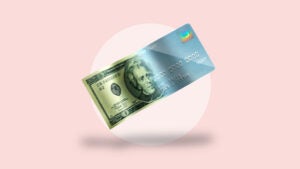Survey: Credit card debt more common when net worth exceeds $100K

Having amassed a significant amount of wealth on paper doesn’t always mean you’re more financially sound than those who haven’t.
According to a new survey from Bankrate Credit Cards, U.S. adults with net worths of $100,000 or more are the most likely to carry credit card debt. This is including those with a negative net worth.
“There is both good debt and bad debt in this world,” says Kayse Kress, financial planner at Physician Wealth Services. “Realistically, good debt brings us closer to our financial goals… Bad debt brings us farther from our goals — like buying a car out of our price range, adding to our credit card debt.”
Types of debt held by U.S. adults
Regardless of net worth, 42 percent of U.S. adults currently have credit card debt, 27 percent have a car loan (whether leasing or financing), 26 percent own a mortgage, 16 percent have a student loan, 12 percent have a personal loan and 3 percent have a home equity loan or line of credit.
Who holds the most credit card debt
When it comes to who holds the most credit card debt among U.S. adults, those with net worths between $100,000 and $199,999 take the cake at 57 percent.
Fifty-eight percent of those with net worths reaching $100,000 and above owe at least $2,500 and 39 percent owe at least $5,000. This is a significant gap compared to the overall population, as 51 percent of U.S. adults owe at least $2,500 in credit card debt and 32 percent owe at least $5,000.
Which generations are affected
Generation X (ages 39 to 54) is most likely to carry credit card debt (51 percent), followed by baby boomers (46 percent), the silent generation (42 percent), millennials (37 percent) and Gen Z (15 percent). Gen X is also most likely to carry some type of debt in general (76 percent) compared to other generations.
These findings are in line with a recent study out of Northwestern Mutual, which found Gen X has accrued more personal debt compared to Gen Z, millennials and baby boomers.
What’s causing credit card debt?
The most common reason for accumulating credit card debt is day-to-day expenses (28 percent), followed by retail purchases like clothing or electronics (16 percent), car repairs or maintenance (11 percent) and medical bills (11 percent).
These findings align with 2019 reporting by CNBC, which found that 23 percent of Americans are going into debt paying for basic needs like food and housing.
For U.S. adults with net worths of $100,000 to $199,999, 21 percent point to day-to-day expenses as the cause of their credit card debt. Twenty percent cite medical bills, 13 percent cite retail purchases, 11 percent cite home repairs and car repairs/maintenance, respectively, and 8 percent cite vacation expenses.
How you can eliminate your credit card debt
No matter what your worth is on paper, paying off your credit card debt as soon as possible is key, says Ted Rossman, credit card industry analyst for Bankrate. “It doesn’t make sense to finance a fancy lifestyle with credit card debt. That’s costing you a lot of money over time and risking your financial stability.”
Track your spending
If day-to-day expenses or superfluous purchases are eating away at your wallet, start tracking your spending to determine where you can afford to cut back.
Jared Andreoli, financial planner at Simplicity Financial LLC, has his clients look at their credit card statements in three-month increments to categorize their purchases. “It helps put a number to their spending, and they feel [their spending] much more,” says Andreoli.
By looking into past credit card statements, you can determine which areas you’re overspending in and identify recurring subscriptions or payments that you can do without, in turn freeing up your wallet for spending on more significant purchases.
You can take this a step further by gamifying your spending, Andreoli says. Say you’re tempted to go to Starbucks and order a coffee and muffin. Each time you pass on an unnecessary desire to spend, you can transfer $5 to your savings.
“This can help slowly change the negative feelings of spending money on something you don’t need into a positive one, that is self-reinforced,” Andreoli says.
Create separate accounts for your spending needs
Once you have your financial vices in check, consider divvying up your disposable income into use-related categories.
Cynthia Meyer, financial planner at Real Life Planning, suggests keeping or creating three accounts for cash management: checking, emergency savings and planned spending (like car insurance, travel and annual memberships).
Doing so forces you to plan for unexpected or occasional payments, like a new drain pipe in your kitchen or a routine oil change.
“Building a cash cushion will help you avoid dipping into your credit cards if you have an unexpected event,” says Meyer.
Consider a balance transfer card
A balance transfer credit card is an effective way to reduce credit card debt and pay it off within an introductory zero percent APR window.
Before you choose a balance transfer card, determine that you can afford to make monthly payments based on the introductory period length and take the balance transfer fee into consideration. (Some cards offer a lower balance transfer fee for transfers made within a certain time period and increase the fee after said time period, such as the Discover it® Balance Transfer.)
You might also consider waiting to make purchases on your balance transfer card until you completely pay off your debt, suggests Meyer.
The bottom line
“Many people think it’s either too late to start better money practices or they are waiting until they earn enough to start saving ‘properly’,” Kress says. “The key to making debt diminish and creating healthy money habits is simple; get started now.”
If you need help tackling your credit card debt, visit Bankrate’s Credit Card Payoff Calculator to create a monthly payoff plan.
Methodology
Bankrate.com commissioned YouGov Plc to conduct a consumer survey. Total sample size was 2,547 adults. Fieldwork was undertaken on November 13th-15th, 2019. The survey was carried out online and meets rigorous quality standards. It employed a non-probability-based sample using both quotas upfront during collection and then a weighting scheme on the back end designed and proven to provide nationally representative results.





